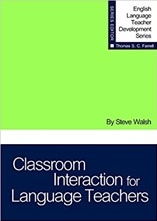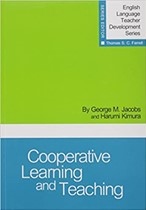Christie Sosa
 Classroom Interaction for Language Teachers by Steve Walsh & Language Cooperative Learning and Teaching by George M. Jacobs and Harumi Kimura
Classroom Interaction for Language Teachers by Steve Walsh & Language Cooperative Learning and Teaching by George M. Jacobs and Harumi Kimura
By Aylin Baris Atilgan Relyea and Kara Mac Donald
The CATESOL Blog Book Review column has provided reviews of short booklets from three development series out of the TESOL Press edited by Thomas S.C. Farrell or Andy Curtis for the CATESOL 2020 fall issues. Since teachers have been busy with the ongoing and continual changes of the online teaching environment during COVID19, the column has offered members with accessible short practice-based and pedagogical-oriented texts that are highly relevant to inform online instruction, provide support and accessible professional development to teachers in the current context. With the end of the fall semester approaching, this will be the last installment of this series. Indeed the semester continues through November and into part of December, but the intention of returning to traditional review of full-length texts in November is that members can read the conventional length book reviews in preparation for possibly selecting reading for professional development over the winter break.
The final installment of the CATESOL 2020 FALL Book Review Sequence for Busy Teachers – Featuring TESOL Press ELT Development Series & English Language Teacher Development Series, Editor Thomas S.C. Farrell and ELT in Context Series, Editor Andy Curtis
Brief Summary to the 2020 Fall Book Review Sequence for Busy Teachers
The CATESOL Blog Book Review column has provided reviews of short booklets from three development series out of the TESOL Press edited by Thomas S.C. Farrell or Andy Curtis for the CATESOL 2020 fall issues. Since teachers have been busy with the ongoing and continual changes of the online teaching environment during COVID19, the column has offered members with accessible short practice-based and pedagogical-oriented texts that are highly relevant to inform online instruction, provide support and accessible professional development to teachers in the current context. With the end of the fall semester approaching, this will be the last installment of this series. Indeed the semester continues through November and into part of December, but the intention of returning to traditional review of full-length texts in November is that members can read the conventional length book reviews in preparation for possibly selecting reading for professional development over the winter break.
Classroom Interaction for Language Teachers by Steve Walsh (2014), Series Editor Thomas S.C. Farrell, TESOL Press
 In the Introduction, Chapter One, Walsh introduces classroom interaction as a key element in effective teaching and learning. The aim of the book is to assist language teachers in improving their professional practice by developing a more informed understanding of classroom interaction by further examining “the complex relationship between language, interaction, and learning”, in order to develop engaged, dynamic instruction with active student involvement in the learning process.
In the Introduction, Chapter One, Walsh introduces classroom interaction as a key element in effective teaching and learning. The aim of the book is to assist language teachers in improving their professional practice by developing a more informed understanding of classroom interaction by further examining “the complex relationship between language, interaction, and learning”, in order to develop engaged, dynamic instruction with active student involvement in the learning process.In Chapter Two, the author depicts main features of second language classroom interaction as “control of the interaction, speech modification, elicitation, and repairs”, and illustrates them using data extracts. He also considers how interaction is typically structured and underlines that “the particular teaching goal and teacher’s understanding of local text” determine the use of strategies in the classroom.
Chapter Three brings attention to classroom discourse and spoken interaction. The author highlights the teacher Initiation, a student Response, and a teacher Feedback/Evaluation Sequence known as IRF, or IRE; as the most typical and predictable structure of classroom discourse. He argues that an awareness of IRF can lead to creating alternative types of sequence. Walsh also emphasizes the importance of understanding the structure of classroom interaction for teachers as he claims the discourse is taught via the teacher.
Chapter Four highlights the author’s case for placing interaction at the core of teaching pedagogies. He introduces specific teacher language features that engage learners and facilitate their learning by providing an extract. The features observed in the extract are direct repair, content feedback, confirmation, checks, extended wait time, and scaffolding. The author elaborates on these features and their roles in creating effective, collaborative, and sound pedagogical practices.
He brings forth the importance of teacher-generated data, compiled from teachers’ interactions with students recorded, or recorded and transcribed, using multiple methods such as: classroom recording with interview, lesson observation, and focus group; therefore, using more than one type of data to understand the classroom discourse. The author claims that this examination and reflective practice will improve the professional practice and enhance learning and learning opportunities of ESL and EFL teachers.
Chapter Five suggests future developments both for teachers and learners in the area of interaction for language teaching. The author informs that most teacher education programs have adapted a two-strand model: subject-based preparation and training in class methodology. He proposes to have the third strand, classroom interaction, highlighting the importance of it in teaching and learning as well as helping teachers to develop an awareness of their local contexts. This in turn, he concludes, will improve classroom processes. He also suggests that teachers acquire classroom interactional competence to maximize learning. From a learner’s perspective, the author points out that the learners need to play a more equal and central role in the classroom discourse to co-construct meaning as well negotiate and ask for clarification.
Walsh’s book is a great contribution to the field of teacher education. The importance of the role of interaction in language teaching and learning is highlighted, demonstrated skillfully, and related to teaching practices. The Reflective Break questions raise teachers’ awareness on their own discourse, interactional skills, and competence in the classroom. This book will help teachers excel in their professional development journey by strengthening their interactions and interactional competence with learners through reflective and pedagogical practices.
Aylin Baris Atilgan Relyea is ESL Faculty at the Santa Rosa Junior College, Santa Rosa, CA, where she provides ESL instruction and creates curriculum development materials. She is the Chair of TESOL International Organization Second Language Writing Interest Section.
Language Cooperative Learning and Teaching by George M. Jacobs and Harumi Kimura (2013), Series Editor Thomas S. C. Farrell, TESOL Press
 In the Introduction, Chapter One, defines what is cooperative learning (CL) and how it differs from group activities) and lays out an overview of the booklet’s chapters and the value for classroom instruction. In short, the author explains that group activities with significant pre-planning and active reflection on what was achieved, as opposed to conventional group work which can often be on the fly in response to a lesson in action or activities that are planned but may not have the reflection on action as part of the process.
In the Introduction, Chapter One, defines what is cooperative learning (CL) and how it differs from group activities) and lays out an overview of the booklet’s chapters and the value for classroom instruction. In short, the author explains that group activities with significant pre-planning and active reflection on what was achieved, as opposed to conventional group work which can often be on the fly in response to a lesson in action or activities that are planned but may not have the reflection on action as part of the process.The next chapter answers the natural question – Why Use Group Activities, and also addresses the challenges that come with their use but closes with the ultimate benefits of utilizing them in the classroom for learner development. Various well-known SLA/ELT scholars are briefly cited to highlight how interaction positively influences a broad range of personal and interactional dimensions. As mentioned, possible challenges are discussed through a sample scenario, as was offered with the benefits of group work. Within the chapter’s sections, reflective questions presented in ‘break boxes’ for the reader to further engage in a personal dialogue with and within the text.
With the value of group work established, Chapter Three moves to describing how to arrange for CL and highlights that there are no strict rules on how to develop and conduct group work as CL but offers some guidance. It outlines the value of ‘Attention Signals’, ‘Seating Arrangement’, ‘Group Size’ and ‘Group Membership’. As before, of CL activities and ‘break boxes’ are present throughout.
Chapter Four deals with teaching principles for interaction that assist in bringing groups and members into a cohesive operating entity and permit leveraging ability to participate, while holding members accountability and develop a community of practice. Scenarios to set the stage for the content and ‘reflection breaks’ are present, which allow the reader to personally relate and unpack the content.
Chapter Five addresses building group cohesion and outlines group autonomy, heterogeneous grouping, cooperative value and using cooperative skills. The chapter offers scenarios to with some sample activities to develop group dynamics to facilitate classroom interaction through CL.
With communicative and meaningful interaction in the language classroom as established norms for best practices on the discussion on CL offers another aspect in designing such activities for the classroom. The discussion and principles are also particularly meaningful for online language teaching for those experienced as well as new to virtual teaching platforms. The text is meaningful for today’s context, a transition back to classrooms in a hybrid manner and/or full f2f teaching.
Kara Mac Donald is an Academic Student and Faculty Development Trainer at the Defense Language Institute Foreign Language Center, Monterey, CA, where she supports both teachers and students in academic development.
In the online and virtual teaching world, these books are refreshers on classroom interaction and cooperative learning appropriate with the ongoing need to generate and offer communication language learning opportunities in the virtual language classroom. These texts provide easy accessible guidelines and examples that can be quickly applied to the online classroom from K-12 to higher education.
Call for Book Review Co-Authors
If you are interested in co-authoring a book slated for the coming months or if you would like to recommend a book that you would like to review as co-author/sole author in future issues, please contact Kara Mac Donald, kmacd@rocketmail.com